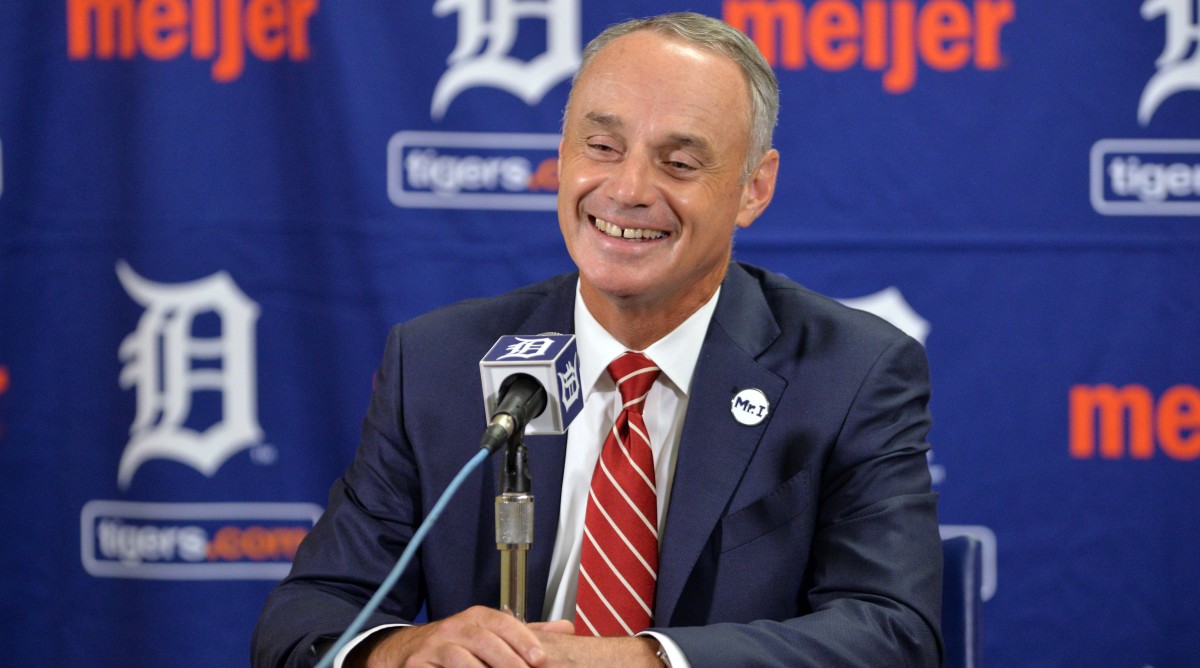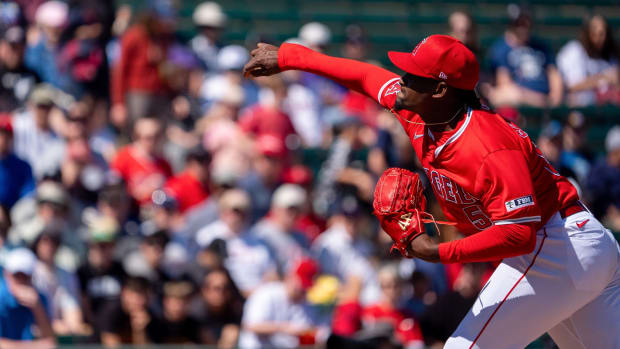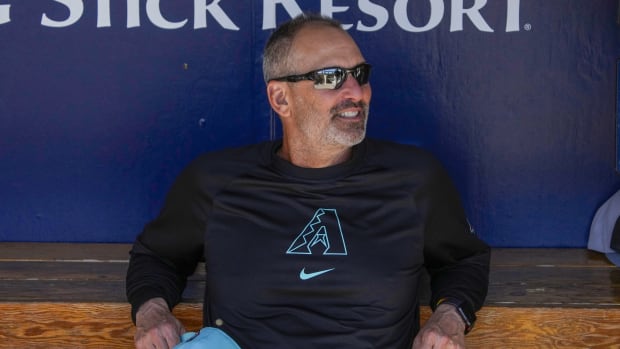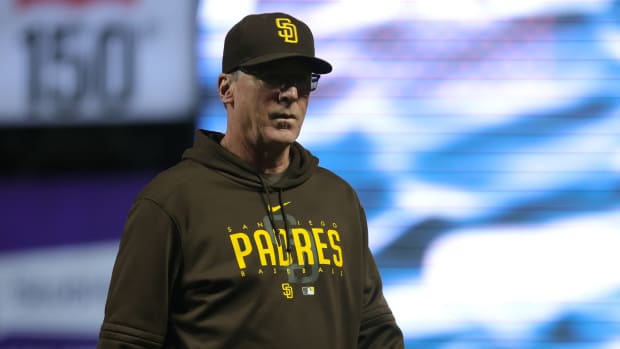If MLB Considers Expansion, What Would a 32-Team League Look Like?
Against the backdrop of the current postseason excitement, talk of the first Major League Baseball expansion since 1998 is in the air thanks to a recent Baseball America report. Written by Spink Award winner Tracy Ringolsby, the report describes "a building consensus" within the industry that a 32-team configuration is inevitable, with Portland likely to be one of the sites for a new team. In the report, Ringolsby presented his own proposal, one that includes a radical realignment, a longer postseason and a 156-game schedule. The schedule would be designed to "allow MLB to address the growing concerns of the union about travel demands and off days." If nothing else, it’s a provocative plan. The extent to which it would reshape the game, however, might be too extreme to happen in one fell swoop.
As was the case in both 2015 and '16, the latest talk of expansion was spurred by comments from commissioner Rob Manfred, who at the BBWAA All-Star Game press conference in Miami cited the city of Montreal as a frontrunner for a franchise and broached the topic again during a visit to the Mariners' Safeco Field in September. Questioned about expansion by reporters, Manfred underscored the need to include a team in the west and reiterated that "Portland would be on the list." Ringolsby reported that "a legitimate ownership group in Portland … has the necessary financing along with support for a stadium, which would be partially funded by a $150 million grant." That money is from a 2003 effort to woo the Expos to Portland; House Bill 3606 allocated the funds via a percentage of MLB players' income tax revenue. A report by The Oregonian identified former Trail Blazers broadcaster Mike Barrett as part of the Portland group.
Manfred has mentioned other potential cities in his discussions—last year I examined half a dozen of them including both Montreal and Portland—but has said at every turn that resolutions to the ongoing stadium sagas in Oakland and Tampa Bay takes priority among the owners. The A's formally proposed a site in September, but that’s hardly a done deal, and the end of the Rays’ search is nowhere in sight. As a result, there's nothing imminent about expansion.
How the Yankees' Advanced Youth Development Keyed Their ALCS Game 5 Win Over Astros
MLB is currently in its longest post-1960 stretch without expansion; the most recent round was in 1998, when the Arizona Diamondbacks and Tampa Bay Devil Rays joined the NL and AL, respectively, and the Milwaukee Brewers shifted to the National League to keep the leagues with even numbers of teams. For the 2013 season, the Houston Astros were moved from the NL Central to the AL West so that all six divisions would consist of five teams.
Ringolsby's proposal is a thoughtful one, but its most radical components—realignment, the shorter schedule and yet another enlargement of the postseason—may be tough to swallow, either for teams, fans, or both. A closer look at each of those topics reveals many of the obstacles that could derail any expansion plan, not just this one.
Realignment
On one level, the primary goal of realignment is laudable, in that it would lessen the amount that players travel. As it is, west coast teams face a much greater burden because they're so spread out, and this places them at a competitive disadvantage. In 2016, Baseball Savant calculated that the Mariners log roughly twice as many air miles as the Cubs (47,704 to 24,271), and all five AL West teams ranking among the top seven in mileage traveled. A study published in 2017, covering 20 years of data (1992–2011), showed that teams crossing two or three time zones without having the proper time to adjust their sleep schedules performed worse than average, and that teams traveling east were at a greater disadvantage, with the Washington Post's Ben Guarino concluding that upon returning home, "The effects are sufficiently large to erase the home field advantage.”
Ringolsby's proposal, which includes franchises in Montreal and Portland, addresses that, calling for four eight-team geographic divisions in which play would be concentrated via an unbalanced schedule (I’ll get to that) and doing away with the separation of American and National Leagues that has been in place since the former was founded in 1901 (implicitly, this would resolve the designated hitter question, but we’ll set that aside). For emphasis, I've italicized the AL teams to offset them from the NL ones:
East: Atlanta, Baltimore, Cincinnati, Miami, Philadelphia, Pittsburgh, Tampa Bay, Washington
North:Boston, Cleveland, Detroit, Minnesota, Montreal, New York Yankees, New York Mets, Toronto
Midwest: Chicago Cubs, Chicago White Sox, Colorado, Houston, Kansas City, Milwaukee, St. Louis, Texas
West:Anaheim, Arizona, Los Angeles, Oakland, Portland, San Diego, San Francisco and Seattle
That's quite a shakeup, one that would dilute several longstanding rivalries. The separation of the Orioles from the Yankees and Red Sox would demolish rivalries that predate the division play era, while that of the White Sox and Tigers goes all the way back to the league’s inception. The “rivalries” of the Mets and Braves, as well as Nationals and Phillies would upset the status quo as well, though their fans could probably stand fewer reminders of heartbreak from the past two decades. Recall that Mets-Braves didn't really become a thing until the three-division era that began in 1994, since Atlanta was inexplicably assigned to the NL West in 1969 (the Cardinals remained in the East to preserve their rivalry with the Cubs).
Beyond the rivalries are the financial implications and a built-in tension: the highest-revenue teams, which generally have the largest payrolls, also draw the best on the road. On the one hand, keeping up with the monetary might of the Yankees and Red Sox—who ranked first and third in the majors in revenue last year according to Forbes—presents a challenge for, say, the Orioles, but so would losing the 19 home dates per year that they provide. Since baseball is an inherently conservative industry when it comes to change, it’s entirely possible that preserving the status quo would have an advantage in most cases. The AL East teams whose attendance gets goosed by Yanks/Sox might prefer things that way, and likewise for the NL West opponents of the Dodgers and Giants.
Based on Forbes' figures, the AL East produced 29% more revenue than the AL Central in 2016 (the most recent year for which data is available) even with the 30th-ranked Rays as part of the equation. Their stadium and media rights situations are major parts of that ranking, and both will presumably improve in the coming years. A revenue-boosting new ballpark is apparently a necessary precursor to expansion and the Rays' current TV deal, which is tied for the lowest in the game at $20 million per year according to FanGraphs, expires in 2018.
How Carlos Beltran Sparked Traditional Clubhouse Chemistry for the Data-Crazed Astros
Given the financial woes of the late Expos, it’s not a given that a new Montreal team be competitive within the same division with the Yankees and Red Sox, and smaller market teams such as the Twins (22nd in revenue last year according to Forbes) and Indians (27th) may not be keen on competing with the big-spending behemoths as well. Likewise for the Rockies and Royals (23rd and 24th) in the same division with the Cubs (fourth).
This isn't the first time the concept of realignment has been floated; it reared its head in 1997 and again in 2010. Amid those discussions, the MLB Players Association was said to oppose seven-or eight-team divisions due to the stigma of finishing so low in the standings, and teams in two-team cities voiced concerns. In the Ringolsby scenario, would the tight-fisted Mets and White Sox want to compete in the same markets with the free-spending Yankees and Cubs?
As with the fault lines that led to the 1994 players’ strike, it’s not hard to see a band of smaller-market teams blocking this whole proposition, and no, there's no way in hell the players will accept a salary cap to place teams on a more equal footing in exchange for the introduction of 50 or so new major league jobs. Teams might find it more palatable to go to eight four-team divisions that more closely preserve the current AL/NL split.
Shorter schedule
In the 1980s, owners decided that single-admission doubleheaders were wasteful in the face of escalating salaries and rising attendance. Via the New York Times, a June 10, 2017 twin bill between the Rays and A's was just the second time since 2004 that teams have elected to schedule such games (as opposed to cobbling them together to make up postponed games). Without doubleheaders, the number of off days during the regular season has dwindled, placing further stresses on players already frazzled by travel. Teams play their 162 games within a 183-day span, which comes out to one off day for every 8.7 games.
Shortening the schedule was a topic of discussion during the negotiations for the Collective Bargaining Agreement unveiled last December, but the schedule remained unchanged. The union had proposed reverting to a 154 game schedule, akin to the one in place until the leagues first expanded in 1961 and '62, but was unwilling to roll back salaries, believing that with a bit more rest, players would be more consistently available and the overall product would improve. Manfred and the owners weren’t buying, with the commissioner saying, “You want to work less, usually you get paid less.”
Ringolsby's proposal calls for a 156-game schedule that would include 12 games (six home and six road) against teams within the same divisions, down from 19 in the current format, and then three games against each of the 24 others. Implicitly, that would mean each team plays a three-game series in those cities just once every two years, which might be more often than some of the current, far-flung interleague matchups, but again, that would explode longstanding ties in existing divisions. To stick with the Orioles as an example, would they willingly surrender 16 games a year hosting either the Red Sox or Yankees, going from 19 all the way down to three? That may be a tough sell.
The Javier Baez Show Arrives To Save the Cubs in their NLCS Game 4 win over the Dodgers
A better proposal is a move away from the 162-game schedule. There's nothing sacrosanct about that number, even if it's been significant for more than half a century. Some single-season records date back to the 154-game era and speak to dramatically different conditions than those today, particularly when it comes to pitching. As we saw this year with the case of Giancarlo Stanton, schedule length is no longer the primary issue when it comes to debating the validity of the single-season home run record. Given time, baseball fans could grasp the nuances of the 154-, 162- and 156-game eras just as easily they do those of the pre-division, two-division and three-division eras when it comes to postseason formats (more on which momentarily). And as for career totals, it's possible that the slightly shorter schedules, theoretically designed to save a bit of wear and tear, keep players around a bit longer to offset the loss of games.
The upside of the 156-game schedule is that each team gets one off day every week within a schedule that fits into the same footprint as the existing one. Ringolsby’s plan would further limit each road trip to two cities. His belief is that the total savings on travel costs from the less frequent travel outside each division would more than offset the revenue lost from wiping three home games from each team's schedule.
Expanded postseason
Via this plan, the postseason—which grew to four team in 1969 with the advent of division play, eight teams in 1995 via the three divisions and wild card in each league, and 10 teams via the addition of a second wild card in each league in 2012—would grow to 12 teams. Each of the four division winners would advance to the Division Series, and the other eight teams would play four (!) wild card games to determine their opponents. That's double the sudden-death drama from the current format.
That said, the current format isn't universally loved. While it does a better job of penalizing its participants for not winning their divisions—it generally requires teams to call upon their ace, who are subsequently limited to one Division Series start and creates a ripple effect on bullpens—it shifts the focus of the regular season races away from the best teams and towards the middle of the pack. Under the current format, the fourth- and fifth-best teams in each 15-team league make the cut and the sixth, seventh and do not. In this year's AL wild card race, that meant sub-.500 teams battling for playoff spots, a situation that invited ridicule.
As for the wild card games themselves, baseball is a sport where on any given day, even the worst team can beat the best team. It's entirely possible, but hardly fair, that one bad day can undo even a 98-win season, as was the case for the 2015 NL Wild Card-losing Pirates.
Ringolsby's proposal doesn't take advantage of the call from some quarters to expand the wild card format to a best-of-three; the drawbacks of keeping the division winners waiting around for a few days remain. And with the 156-game schedule occupying the same footprint as the 162-game one, the proposal does nothing to prevent the postseason from creeping into November, where the risk of chilly weather having a greater impact on the outcome looms.
As the Bud Selig era showed, MLB can thrive even with significant changes. The sport's revenues have more than quintupled since 1993, from $1.9 billion to over $10 billion annually (per Forbes) while the industry and its audience has coped with the implementation of the wild card, three divisions and interleague play. Further changes are inevitable, as is expansion, but to these eyes, it would seem not only that a shorter season that improves rest and travel conditions for players should also wrap up before Halloween, but that the addition of two teams can be done without ripping apart so many of the rivalries, and so much of the history, that make up the sport's fabric.



































